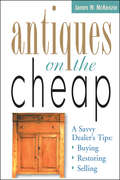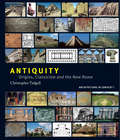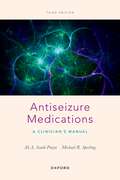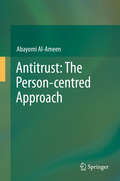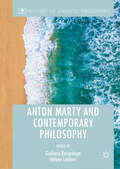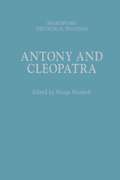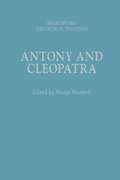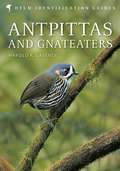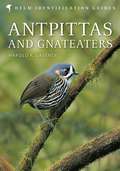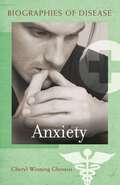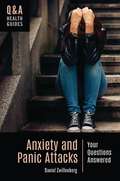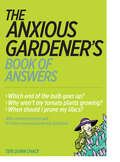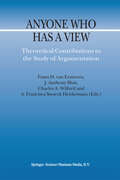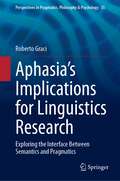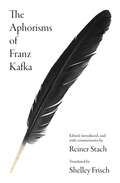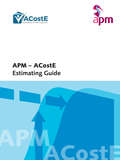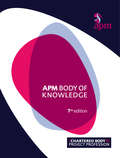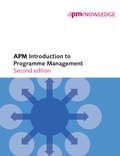- Table View
- List View
Antiques on the Cheap: A Savvy Dealer's Tips: Buying, Restoring, Selling
by James W. McKenzieGet the inside scoop on every aspect of antiquing - buying, cleaning, repairing, embellishing, refinishing, restoring, and selling. You'll find expert advice for getting great deals at auctions, flea markets, and shops, and you'll learn how to spot items that can be repaired to increase their value. Advice for selling antiques at flea markets, on consignment, and in shops is included.
Antiquity: Origins, Classicism and The New Rome
by Christopher TadgellThe first in a new series of five books describing and illustrating the seminal architectural traditions of the world, Antiquity traces architectural history from its very beginnings until the time when the traditions that shape today’s environments began to flourish. More than a catalogue of buildings, in this work Tadgell provides their political, technological, social and cultural contexts and explores architecture, not only as the development of form and space but as an expression of the civilization within which it evolves. The buildings are analyzed and illustrated with over 1200 colour photographs and 400 drawings while the societies that produced them are brought to life through a broad selection of their artefacts.
Antiquity: Origins, Classicism and The New Rome
by Christopher TadgellThe first in a new series of five books describing and illustrating the seminal architectural traditions of the world, Antiquity traces architectural history from its very beginnings until the time when the traditions that shape today’s environments began to flourish. More than a catalogue of buildings, in this work Tadgell provides their political, technological, social and cultural contexts and explores architecture, not only as the development of form and space but as an expression of the civilization within which it evolves. The buildings are analyzed and illustrated with over 1200 colour photographs and 400 drawings while the societies that produced them are brought to life through a broad selection of their artefacts.
Antiseizure Medications: A Clinician's Manual
by Ali A. Asadi-Pooya Michael R. SperlingThis new edition of Antiseizure Medications: A Clinician's Manual reflects the advances in the study and treatment of epilepsy in the past several years. As a practical tool for physicians and other healthcare providers, this text focuses on the selection and use of antiseizure medications in a variety of clinical contexts. In the past decade, many new antiseizure medications (ASMs) have been introduced, so that there are now approximately 30 medications available to treat epilepsy. The healthcare provider therefore has many choices. However, having many alternatives also allows for the possibility of choosing an inappropriate or a suboptimal agent. The choice of medication should be guided by knowledge and familiarity with the ASMs. In this new edition, the authors discuss choosing drugs when faced with various medical comorbidities; how to correctly prescribe, titrate, and taper drugs; how to monitor drug efficacy and side effects; how to diagnose and manage toxicity; interactions with other drugs; and other relevant issues. With updated references, terminology, materials, and drugs, this third edition meets the needs of clinicians who must treat their patients living with epilepsy.
Antiseizure Medications: A Clinician's Manual
by Ali A. Asadi-Pooya Michael R. SperlingThis new edition of Antiseizure Medications: A Clinician's Manual reflects the advances in the study and treatment of epilepsy in the past several years. As a practical tool for physicians and other healthcare providers, this text focuses on the selection and use of antiseizure medications in a variety of clinical contexts. In the past decade, many new antiseizure medications (ASMs) have been introduced, so that there are now approximately 30 medications available to treat epilepsy. The healthcare provider therefore has many choices. However, having many alternatives also allows for the possibility of choosing an inappropriate or a suboptimal agent. The choice of medication should be guided by knowledge and familiarity with the ASMs. In this new edition, the authors discuss choosing drugs when faced with various medical comorbidities; how to correctly prescribe, titrate, and taper drugs; how to monitor drug efficacy and side effects; how to diagnose and manage toxicity; interactions with other drugs; and other relevant issues. With updated references, terminology, materials, and drugs, this third edition meets the needs of clinicians who must treat their patients living with epilepsy.
Antitrust: The Person-centred Approach
by Abayomi Al-AmeenThis book proposes a different approach to theorising and analysing antitrust issues, working on the premise that at present, antitrust is addressed from top-down and narrow perspectives which in effect limit the attention paid to or exclude issues that could otherwise be considered. This reasoning is motivated by the pursuit of inclusiveness and broadness in the antitrust context. The work contends that traditional top-down antitrust theories are weak because they are incomplete and insufficient in their description and analysis of antitrust issues. Thus, it identifies the need to construct a bottom-up approach. Invariably, such an approach would have to avoid ex ante judgments about the suitability of the normative contents of antitrust laws and theories, lest it fall into the same trap that plagues traditional theories. As a possible solution, the author proposes a procedural account referred to as the person-centred approach (built on theories such as Sen’s Capability) and carefully reviews its practicality.
Anton Marty and Contemporary Philosophy (History of Analytic Philosophy)
by Giuliano Bacigalupo Hélène LeblancThis edited collection of eight original essays pursues the aim of bringing the spotlight back on Anton Marty. It does so by having leading figures in the contemporary debate confront themselves with Marty’s most significative contributions, which span from philosophy of mind, philosophy of language and ontology to meta-metaphysics and meta-philosophy. The book is divided in three parts. The first part is dedicated to themes in philosophy of language, which were at the centre of Marty’s philosophical thinking throughout his life. The second part focuses on the problem of the objectivity and phenomenology of time and space, upon which Marty was working in the final years of his life. The final part turns to Marty’s meta-metaphysical and meta-philosophical considerations. The intended audience of this book are primarily scholars and students interested in the relevant contemporary debates, as well as scholars working on the Austrian tradition.
Antony and Cleopatra: Shakespeare: The Critical Tradition (Shakespeare: The Critical Tradition)
by Joseph Candido Professor Brian VickersThis new volume in the Shakespeare: The Critical Tradition series increases our knowledge of how Antony and Cleopatra has been received and understood by critics, editors and general readers. The volume provides, in separate sections, both critical opinions about the play across the centuries and an evaluation of their positions within and their impact on the reception of the play. The chronological arrangement of the text-excerpts engages the readers in a direct and unbiased dialogue, and the introduction offers a critical evaluation from a current stance, including modern theories and methods. This volume makes a major contribution to our understanding of the play and of the traditions of Shakespearean criticism surrounding it as they have developed from century to century.
Antony and Cleopatra: Shakespeare: The Critical Tradition (Shakespeare: The Critical Tradition)
by Joseph Candido Professor Brian VickersThis new volume in the Shakespeare: The Critical Tradition series increases our knowledge of how Antony and Cleopatra has been received and understood by critics, editors and general readers. The volume provides, in separate sections, both critical opinions about the play across the centuries and an evaluation of their positions within and their impact on the reception of the play. The chronological arrangement of the text-excerpts engages the readers in a direct and unbiased dialogue, and the introduction offers a critical evaluation from a current stance, including modern theories and methods. This volume makes a major contribution to our understanding of the play and of the traditions of Shakespearean criticism surrounding it as they have developed from century to century.
Antpittas and Gnateaters
by Harold Greeney David BeadleElusive study organisms for ornithologists and highly prized additions to the birder's life-list, the antpittas (Grallariidae) and gnateaters (Conopophagidae) are among the most poorly known Neotropical bird groups. This authoritative handbook is the first book dedicated solely to these two families, combining an exhaustive review of more than two centuries of literature with original observations by the author and many knowledgeable contributors. Antpittas and Gnateaters provides a thorough guide to the identification and ecology of these birds, with detailed maps accompanying the text. A series of superb plates illustrate most of the 156 recognized taxa; supplemented by more than 250 colour photographs, the immature plumages and natural history of many species are depicted for the first time. This book is the ultimate reference on these remarkable and beautiful birds, and an indispensible addition to the libraries of researchers and birders for many years to come.
Antpittas and Gnateaters
by Harold Greeney David BeadleElusive study organisms for ornithologists and highly prized additions to the birder's life-list, the antpittas (Grallariidae) and gnateaters (Conopophagidae) are among the most poorly known Neotropical bird groups. This authoritative handbook is the first book dedicated solely to these two families, combining an exhaustive review of more than two centuries of literature with original observations by the author and many knowledgeable contributors. Antpittas and Gnateaters provides a thorough guide to the identification and ecology of these birds, with detailed maps accompanying the text. A series of superb plates illustrate most of the 156 recognized taxa; supplemented by more than 250 colour photographs, the immature plumages and natural history of many species are depicted for the first time. This book is the ultimate reference on these remarkable and beautiful birds, and an indispensible addition to the libraries of researchers and birders for many years to come.
Anxiety (Biographies of Disease)
by Cheryl Winning GhinassiThis engagingly written survey covers the history of anxiety disorders and current approaches to their definition and treatment.Anxiety disorders are significant mental health illnesses that impair lives and cost society millions of dollars in health care expenses and lost productivity. Greater awareness of anxiety disorders is essential for both the general public and health professionals if those who suffer from them are to be identified, receive proper treatment, and have a chance at leading fulfilling lives.To that end, Anxiety begins with a historical overview of the ways in which anxiety disorders have been understood, from the prehistoric era until the present time, examining the disorders from the perspectives of conceptualization, classification, research, and treatment. Subsequent chapters examine these themes in light of our current understanding and approaches to anxiety disorders. Current diagnostic and assessment methods are discussed, as are modern treatment options. The book concludes with a survey of the future directions in research for the understanding and treatment of anxiety disorders.
Anxiety and Panic Attacks: Your Questions Answered (Q&A Health Guides)
by Daniel Zwillenberg PsyDA new title in the Q&A Health Guides series, this book tackles readers' questions regarding anxiety and panic attacks, dispelling misconceptions and examining real-world scenarios that highlight important concepts and controversies.How is social anxiety different from shyness or introversion? Are anxiety disorders only a problem in the Western, industrialized world, and if not, are they expressed differently in other cultures? Why do some people suffer from panic attacks while others do not? What kinds of therapy and medication are available for anxiety? What happens in therapy? How can well-meaning family and friends help a person with an anxiety disorder rather than make things worse? Anxiety and Panic Attacks: Your Questions Answered addresses all of these topics and much more, presenting information in a question-and-answer format that makes finding the desired information easy. The book begins with a "Guide to Health Literacy" section that explains what health literacy is and provides readers with tools to improve their health literacy, and then examines five myths and misconceptions about anxiety and supplies five case studies that provide real-world context and reinforce the concepts discussed in the book. All of the Greenwood Q&A Health Guides series books are specifically designed to provide readers with authoritative yet accessible answers to their questions in a concise, targeted resource that they can trust to be medically accurate.
Anxiety and Panic Attacks: Your Questions Answered (Q&A Health Guides)
by Daniel Zwillenberg PsyDA new title in the Q&A Health Guides series, this book tackles readers' questions regarding anxiety and panic attacks, dispelling misconceptions and examining real-world scenarios that highlight important concepts and controversies.How is social anxiety different from shyness or introversion? Are anxiety disorders only a problem in the Western, industrialized world, and if not, are they expressed differently in other cultures? Why do some people suffer from panic attacks while others do not? What kinds of therapy and medication are available for anxiety? What happens in therapy? How can well-meaning family and friends help a person with an anxiety disorder rather than make things worse? Anxiety and Panic Attacks: Your Questions Answered addresses all of these topics and much more, presenting information in a question-and-answer format that makes finding the desired information easy. The book begins with a "Guide to Health Literacy" section that explains what health literacy is and provides readers with tools to improve their health literacy, and then examines five myths and misconceptions about anxiety and supplies five case studies that provide real-world context and reinforce the concepts discussed in the book. All of the Greenwood Q&A Health Guides series books are specifically designed to provide readers with authoritative yet accessible answers to their questions in a concise, targeted resource that they can trust to be medically accurate.
The Anxious Gardener's Book of Answers
by Teri Dunn ChaceThe Anxious Gardener's Book of Answers identifies the 100 most common gardening mistakes and gives gardeners the techniques to prevent them. Or, if it's too late and they've already goofed, there are tips to fix the mistake. The book's 24 chapters tackle every kind of gardening disaster, whether it has to do with plants, tools and techniques, or general care and maintenance. Gardeners looking to prune their roses will learn to hold off until late winter to avoid damaging plant tissue. Gardeners that have allowed their mint to overgrow? Dunn advises pulling it out and replanting it in a container to control the root. Organized by common garden topics and designed to be easily dipped in and out of, The Anxious Gardener's Book of Answers offers nuggets of wisdom based on Teri Dunn Chace's years of hands-on gardening experience. Advice is humorously supported by Colleen Coover's delightful illustrations. This accessible guide will transform an anxious gardener into an informed, confident, successful gardener with a mistake-free garden
Anyone Who Has a View: Theoretical Contributions to the Study of Argumentation (Argumentation Library #8)
by Frans H. Van Eemeren J. Anthony Blair Charles A. Willard A. Francisca Snoeck HenkemansThis volume contains a selection of papers from the International Conference on Argumentation (Amsterdam, 2002) by prominent international scholars of argumentation theory. It provides an insightful cross-section of the current state of affairs in argumentation research. It will be of interest to all those working in the field of argumentation theory and to all scholars who are interested in recent developments in this field.
Aphasia’s Implications for Linguistics Research: Exploring the Interface Between Semantics and Pragmatics (Perspectives in Pragmatics, Philosophy & Psychology #35)
by Roberto GraciThis volume stresses the importance of a multidisciplinary perspective in deepening knowledge of the interface between semantics and pragmatics. It thoroughly investigates concepts belonging to Neo-Gricean and post-Gricean theories. Theoretical research in pragmatics has challenged the idea of a close relation between literal meaning and the explicitly conveyed proposition, claiming that situational context is responsible for an ongoing process of adjusting and revising what a speaker says. Similarly, recent discoveries from the clinical side have highlighted the importance of extra-linguistic sources and the cognitive context in the syntactic and semantic competence of people with language disorders. The productive comparison between reflections from theoretical pragmatics and the most recent developments in cognitive sciences provides an authentic way of addressing traditional philosophical issues, moving them to a new fertile ground. The research herein is gathered across disciplines to provide theoretical and clinical contributions and collaborations, making this book broadly appropriate to students, researchers and professionals in the fields.
The Aphorisms of Franz Kafka
by Franz KafkaA splendid new translation of an extraordinary work of modern literature—featuring facing-page commentary by Kafka’s acclaimed biographerIn 1917 and 1918, Franz Kafka wrote a set of more than 100 aphorisms, known as the Zürau aphorisms, after the Bohemian village in which he composed them. Among the most mysterious of Kafka’s writings, they explore philosophical questions about truth, good and evil, and the spiritual and sensory world. This is the first annotated, bilingual volume of these extraordinary writings, which provide great insight into Kafka’s mind. Edited, introduced, and with commentaries by preeminent Kafka biographer and authority Reiner Stach, and freshly translated by Shelley Frisch, this beautiful volume presents each aphorism on its own page in English and the original German, with accessible and enlightening notes on facing pages.The most complex of Kafka’s writings, the aphorisms merge literary and analytical thinking and are radical in their ideas, original in their images and metaphors, and exceptionally condensed in their language. Offering up Kafka’s characteristically unsettling charms, the aphorisms at times put readers in unfamiliar, even inhospitable territory, which can then turn luminous: “I have never been in this place before: breathing works differently, and a star shines next to the sun, more dazzlingly still.”Above all, this volume reveals that these multifaceted gems aren’t far removed from Kafka’s novels and stories but are instead situated squarely within his cosmos—arguably at its very core. Long neglected by Kafka readers and scholars, his aphorisms have finally been given their full due here.
The Aphorisms of Franz Kafka
by Franz KafkaA splendid new translation of an extraordinary work of modern literature—featuring facing-page commentary by Kafka’s acclaimed biographerIn 1917 and 1918, Franz Kafka wrote a set of more than 100 aphorisms, known as the Zürau aphorisms, after the Bohemian village in which he composed them. Among the most mysterious of Kafka’s writings, they explore philosophical questions about truth, good and evil, and the spiritual and sensory world. This is the first annotated, bilingual volume of these extraordinary writings, which provide great insight into Kafka’s mind. Edited, introduced, and with commentaries by preeminent Kafka biographer and authority Reiner Stach, and freshly translated by Shelley Frisch, this beautiful volume presents each aphorism on its own page in English and the original German, with accessible and enlightening notes on facing pages.The most complex of Kafka’s writings, the aphorisms merge literary and analytical thinking and are radical in their ideas, original in their images and metaphors, and exceptionally condensed in their language. Offering up Kafka’s characteristically unsettling charms, the aphorisms at times put readers in unfamiliar, even inhospitable territory, which can then turn luminous: “I have never been in this place before: breathing works differently, and a star shines next to the sun, more dazzlingly still.”Above all, this volume reveals that these multifaceted gems aren’t far removed from Kafka’s novels and stories but are instead situated squarely within his cosmos—arguably at its very core. Long neglected by Kafka readers and scholars, his aphorisms have finally been given their full due here.
APM – ACostE Estimating Guide
by Association for Project Management Association of Cost EngineersEverything you need to know about estimating in one essential guide. Estimates are critical to project professionals; vital when making informed decisions about projects across the different stages of the entire project life cycle to ensure successful project delivery. A cooperation between the Association for Project Management (APM) and the Association of Cost Engineers (ACostE) this guide is vital for project professionals across various sectors, as well as anyone who needs to understand cost estimation. Created by collaborators with real-life experiences, Estimating Cost will help you understand and diligently apply the core values of estimating cost to improve the clarity and robustness of an estimate for better decision making. Key features include: * practical advice with a focus on cost estimating approaches, such as top-down, bottom-up, and ‘ethereal’; * guidance on the various estimating methods including analogy, parametric and trusted source; * applicability to the private sector and on a wide range of projects; * key figures, diagrams and frameworks you can build on and apply to your estimates.
APM Body of Knowledge
by Association for Project Management StaffThe APM Body of Knowledge is a foundational resource, providing the concepts, functions and activities that make up professional project management. It seeks to reflect the developing profession, recognising project-based working at all levels, and across all sectors for influencers, decision makers, project professionals and their teams. Key features include: An extended life cycle structure from the strategic case for projects to the delivery of benefits. An expanse of topics covering iterative and linear life cycles, personal wellbeing, PMOs and other strategic functions. Over 200 recommended reading materials, including APM publications, that professionals can use to expand their knowledge. A comprehensive glossary of key terminology that run throughout the book, from topic to topic. “As a foundational resource, written by the profession for the profession, we hope you find the content informative and useful in guiding your endeavours to deliver beneficial change through the management of projects, programmes and portfolios.” Dr Ruth Murray-Webster, editor, APM Body of Knowledge 7th edition Readers of this publication may also be interested in the Directing Change, Planning, Scheduling, Monitoring and Control and Sponsoring Change
APM Guide to Contracts and Procurement (PDF)
by Apm Contracts Procurement SigAPM Guide to Contracts and Procurement: For Project, Programme and Portfolio Managers offers a basic understanding of ‘how to’ procure sub-project works and to manage delivery through the phases of the procurement life cycle. The guide breaks down the process of procurement of significant packages of work into individual stages. This enables the busy project manager to swiftly understand the key points required at the outset, or mid-flight, when corrective action may be needed. Each stage includes an easy-to-follow flow diagram, including the necessary inputs and outputs. Created by a panel of authors with hands-on experience, the guide is aimed at project professionals and stakeholders within organisations e.g. financial officers, who wish to increase their awareness of how sub-projects can be procured.
APM Introduction to Programme Management (2nd edition)
by APM Programme Management Specific Interest Group“This update to APM Introduction to Programme Management brings new insights as to what programme management is all about. It is an ‘easy read’ for the top executives, for those relatively new to programme management who have a thirst for knowledge and for the project management community who should, and need to, understand how their project management skills play into the ‘bigger picture’.” Sir John Armitt More than a decade after its release, this substantial refresh of APM Introduction to Programme Management brings practitioners up-to-date with the latest developments in the discipline. As well as the fundamental principles – what a programme is, how it works and how to review progress - the guide also explores the changing environment in which programmes exist, their relationship to the strategic context of organisations as well as ‘new’ frameworks and ways of working. APM Introduction to Programme Management 2nd edition is one of APM’s core introductory texts. Written by experienced practitioners from APM’s Programme Management Specific Interest Group (SIG), it is recommended reading for anyone joining a programme team – or those who want to know how to interact with the programme. Readers of this publication may also be interested in Directing Agile Change. Book Review: “A COMPREHENSIVE INTRODUCTION” This is the second edition of APM Introduction to Programme Management, first published nearly a decade ago. It is an easy read for executives, those relatively new to programme management, and those in the community who should and need to know how project management skills are one aspect of the bigger picture. The book is concise, arranged over three sections and totalling 55 pages. It demonstrates links to other APM Book of Knowledge chapters, and there is a full glossary of terms. The book does not focus on the ‘technical’ aspects of programmes, nor is it aimed at one specific industry. Rather, it iterates that programme management is not simply another level of project management, and explores the organisational and strategic contexts in which programmes exist. Complex discussions are supported by clear and easy-to-understand illustrations. Although the book is based on the before, during and after stages of a programme life cycle, the topics discussed in the three sections are not easily linked to the life cycle. For example, information and benefits management is not discussed until the final pages of the book, whereas, in reality, these are key considerations in the formation of a programme. This is a comprehensive introduction and offers helpful references for those keen to explore particular subject areas. APM Introduction to Programme Management does exactly what the title suggests. Reviewed by Tom Worsnop
APM Project Fundamentals Qualification (PFQ) Exam Syllabus (PDF)
by ApmAPM Project Fundamentals Qualification (PFQ) Exam Syllabus PFQ is an introductory qualification that offers a fundamental awareness of project management terminology, offering a broad understanding of the principles of the profession.
APM Project Fundamentals Qualification (PFQ) Sample Paper (PDF)
by ApmAPM Project Fundamentals Qualification (PFQ) Sample Paper for the PFQ exam
